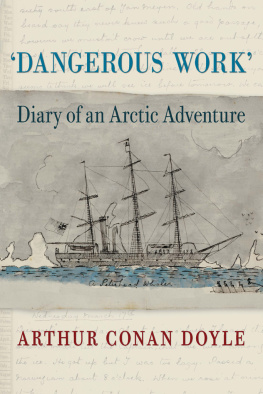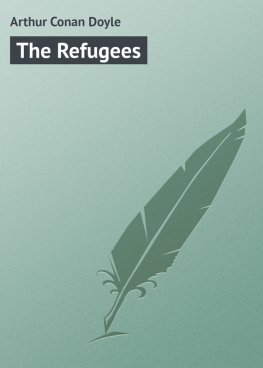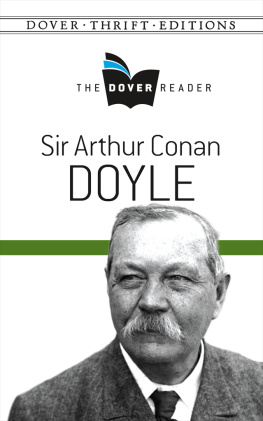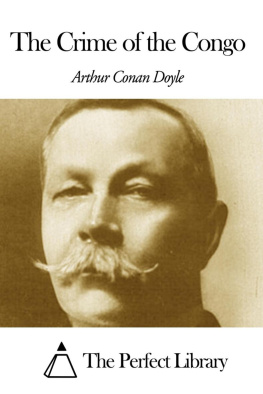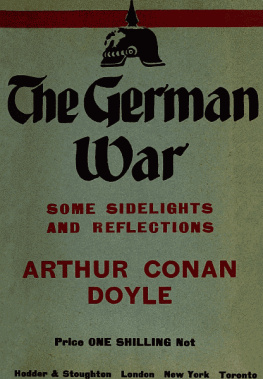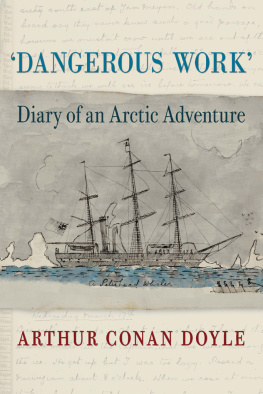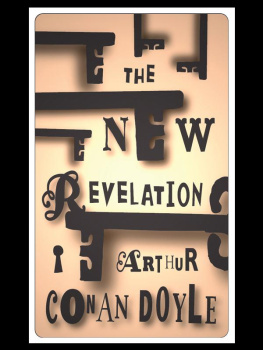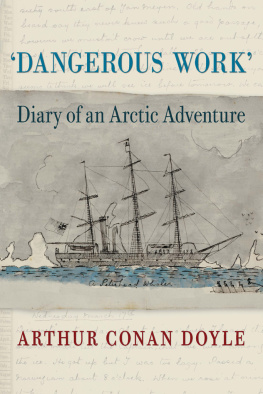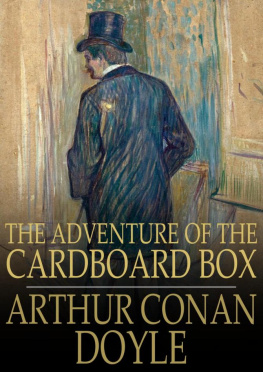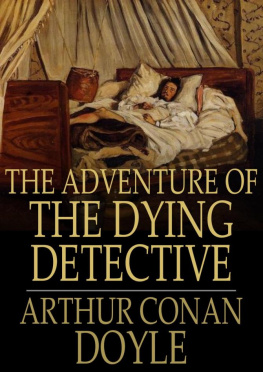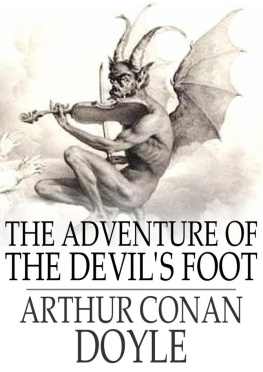Jon Lellenberg and Daniel Stashower are the editors of Arthur Conan Doyle: A Life in Letters and Conan Doyles first novel, The Narrative of John Smith.
The University of Chicago Press, Chicago 60637
The University of Chicago Press, Ltd., London
in introduction and textual annotations, 2012 Jon Lellenberg and Daniel Stashower
in Arthur Conan Doyles diary, 2012 the Conan Doyle Estate Ltd
All rights reserved. Published 2012.
Published in the United States of America
21 20 19 18 17 16 15 14 13 12 1 2 3 4 5
ISBN-13: 978-0-226-00905-6 (CLOTH)
ISBN-13: 978-0-226-00886-8 (E-BOOK)
ISBN-13: 978-0-226-04999-1 (SPECIAL EDITION E-BOOK, EPUB/MOBI)
A CIP record for this title is available at the Library of Congress.
DANGEROUS WORK
Diary of an Arctic Adventure
ARTHUR CONAN DOYLE
Edited by
Jon Lellenberg & Daniel Stashower
A complete facsimile edition is available from
The University of Chicago Press
ISBN-13: 978-0-226-00886-8 (E-BOOK)
THE BRITISH LIBRARY

Arthur Conan Doyle, third from left, 12 July 1880.
(photograph by W.J.A. Grant, courtesy of Hull Maritime Museum.)
Acknowledgments
The editors are grateful for their assistance and encouragement to Christy Allen; Philip Bergem; Peter Blau; Catherine Cooke, Marylebone Library; Alison Corbett; Professor John Corbett, University of Macau; Richard Espley, National Maritime Museum, Greenwich; George Fletcher; Douglas Garden, Shetland Library, Lerwick; Michael Gunton, Laura Weston, and Dianne Cawood, Portsmouth Central Library; Stuart N. Frank, Senior Curator, New Bedford Whaling Museum; Roger Johnson; Timothy Johnson and Julia McKuras, University of Minnesota Libraries Sherlock Holmes Collections; and Dr. Robert S. Katz. Aberdeen University Library, the British Library, London, the Newberry Library, Chicago, Illinois, and the Library of Congress, Washington D.C., also provided valuable support. Finally, the editors are grateful to the family members who, as heirs of Anna Conan Doyle, are the owners of Arthur Conan Doyles whaling diary, for making it available for the preparation of this edition: Catherine Doyle Beggs, Georgina Doyle, Richard Doyle, and Charles Foley.


Arthur Conan Doyle, in practice in Southsea, Portsmouth, early 1880s.
(Courtesy of Conan Doyle Estate Ltd.)
INTRODUCTION
I came of age at 80 degrees north latitude
On a March afternoon in 1880, a young medical student named Arthur Conan Doyle decided on a sudden impulse to suspend his studies and take a berth as ships surgeon on an Arctic whaler. The six-month voyage took him into unknown regions, gave him unimagined sights and experiences, and plunged him into dangerous and bloody work on the ice floes of the Arctic seas. He worked harder under more difficult circumstances than he ever had before, he argued philosophy and religion with his shipmates, and he dodged death on more than one occasion. It proved to be, he said, the first real outstanding adventure of my life.
It came about in this way, he explained years later in his autobiography, Memories and Adventures:
One raw afternoon in Edinburgh, whilst I was sitting reading hard for one of those examinations which blight the life of a medical student, there entered to me one Currie, a fellow-student with whom I had some slight acquaintance. The monstrous question which he asked drove all thought of my studies out of my head.
Would you care, said he, to start next week for a whaling cruise? Youll be surgeon, two pound ten a month and three shillings a ton oil money.
How do you know Ill get the berth? was my natural question.
Because I have it myself. I find at this last moment that I cant go, and I want to get a man to take my place.
How about an Arctic kit?
You can have mine.
In an instant the thing was settled, and within a few minutes the current of my life had been deflected into a new channel.
Conan Doyle was only twenty at the time, and in his third year of medical studies at Edinburgh University. Speaking generally of my university career, he would recall, I was always one of the ruck, neither lingering nor gaining a 60 percent man at examinations. His typically self-effacing comment made light of a good deal of effort and accomplishment in the face of difficult circumstances. In later years he would declare with characteristic cheer that he had been raised in the hardy and bracing atmosphere of poverty, but the remark glossed over considerable domestic turmoil and hardship, with the Doyle family changing addresses at least five times before Arthur was ten. Though it was a genteel poverty, his father Charles Doyle suffered for years from illness and alcohol, until the income from his surveyors post ceased when he was only forty-four.
Somehow money had been found to provide young Arthur with a first-class education at Stonyhurst, a distinguished Jesuit boarding school in England, and upon graduating he felt the need to assume some of his fathers responsibilities and contribute to the welfare of the large family. Perhaps it was good for me that the times were hard, he wrote, for I was wild, full-blooded, and a trifle reckless, but the situation called for energy and application so that one was bound to try to meet it. My mother had been so splendid that we could not fail her. It had been determined that I should be a doctor, chiefly, I think, because Edinburgh was so famous a centre for medical learning.
By now the first seeds of the Sherlock Holmes stories were sown. As a boy Conan Doyle had discovered Edgar Allan Poe, the supreme original short story writer of all time, and would occasionally petrify our small family circle by reading his tales aloud. At Edinburgh University he had the good fortune to serve as an assistant to Dr. Joseph Bell, a physician whose powers of observation and diagnosis were spellbinding. At a glance Bell could often discern not only the nature of a patients ailment, but also numerous details of his background and occupation. To an audience of Watsons, Conan Doyle joked in later years, it all seemed very miraculous until it was explained, and then it became simple enough. The future creator of Sherlock Holmes had already published one mystery story by the age of twenty, thrilled to receive three guineas for it when often he went without lunch in order to spend two pence upon a used book.
Conan Doyles decision to sign onto the Arctic whaling expedition, spontaneous and reckless though it undoubtedly seemed to his industrious and thrifty mother, afforded him a rare set of opportunities. He would indulge his budding taste for adventure, and be paid for doing so. At the same time, his six months aboard ship would give him a chance to nurture his growing ambitions as a writer. Before departing for Peterhead, the Scottish port where he would join the whaler Hope, he augmented Claud Curries seamans kit with several books of poetry, philosophy, They would become a deeply personal chronicle of a young man testing himself as never before.

Diagram of the S.S. Hope, built by Alexander Hall & Co., Aberdeen, at the height of their fame as perhaps the most successful builders of clipper ships in the world. (From Basil Lubbocks
Next page
